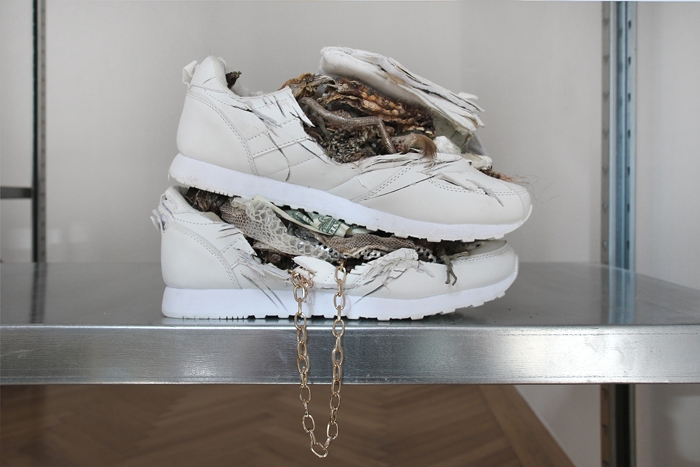The theme of this year’s ‘Curated by’ festival, during which Vienna’s galleries invite international curators to make exhibitions, is a gift for Àngels Miralda. With the tripleheader Weight of Abundance, she interprets the given theme of ‘circulation’ through what Karl Marx called the ‘circulation of commodities’. This, Marx explains in Capital (1867), is ‘the starting-point for capital’, wherein money is not just the way value and prices are measured, or the medium through which things are bought and sold, but the means of acquiring more money as an end in itself, backed by social power. Under Miralda’s auspices, each artist gets one room in the gallery space for their take on this.
Eli Cortiñas pries into the secret lives of commodities and their relation to power. Three works from her collage series From an Ethnological Museum Revisited (2018) show indefinable objects made from different parts of ancient artefacts (bits of statues, pottery, jewellery) grafted onto modern goods. The video Walls Have Feelings (2019), meanwhile, juxtaposes archive clips of dictators, factory workers, police brutality and John Carpenter’s film They Live (1988) with fragments, read by an actor, from the writings of Franco ‘Bifo’ Berardi, Silvia Federici, Achille Mbembe, Zygmunt Bauman and Frantz Fanon. The piece is clear and cluttered at the same time, sending out mixed messages in different voices, all presented as if they are saying the same thing. Levelling the authors’ different approaches ends up emptily commanding us to resist the forces of manipulation – whoever and wherever they are – like a simple reversal of those slogans demanding obedience from They Live.
Débora Delmar is more concerned with the grim toil on which the joy of new purchases depends. The five objects in the l.u.x.u.r.y. Time series (2019) are shoebox lids bearing the name of luxury brands (Versace, Louis Vuitton, Chanel, Dior, Gucci), on which clock mechanisms are mounted. It turns out, however, that these logoed shoeboxes aren’t genuine at all, just knockoffs found in Beijing’s Chaowai Market. There is a joke in there somewhere. The target is the ‘consumer’. But which one? It could be the audience for contemporary art, or the one whose desires are spurred, if not created, by the lustre of brandnames and logos. It could be both at once. After all, just looking at Delmar’s phony trinkets shows up the viewer’s own symbolic capital, since they will either know the products are just simulacra – imitations of an idea of luxury – or not. Delmar’s Commercial Space series (2019) brings us right back to materialist critique. These twill jackets, printed with images of luxury department stores and hung on mannequins – the endpoint of the cycle of production and consumption – remind us first that luxury goods are made by the hands and sweat of real workers (often on the same production lines as clothing destined for discount stores), and secondly that the textile industry is capitalism at its most brutalising.
Nicolás Lamas’s contribution mostly consists of 23 curious sculptures made from mangled consumer goods – old sneakers filled with straw or cactuses, a glass jar containing the remains of a human skull placed inside a laptop’s motherboard, plastic toolboxes with animal bones where the hammers and screwdrivers should be – displayed on an installation of metal shelving units. It’s like a mausoleum for faded desires. The issue is, then, not just how to narrate culture. Rather, by showing us the battered corpses of commodities, Lamas interprets circulation in terms of natural cycles of life and death. He asks if libidinal investments meet the same fate as the things we once wanted so badly, not only growing grey and less supple, but dying and putrefying.
Weight of Abundance at Zeller van Almsick, Vienna, 13 September – 21 November
From the December 2019 issue of ArtReview
